Since the Cold War ended, U.S. politics has seen a series of insurgent candidacies. Pat Buchanan prefigured Trump in the Republican contests of 1992 and 1996. Ralph Nader challenged the Clinton wing of the Democratic Party from the outside in 2000. Ron Paul vexed establishment Republicans John McCain and Mitt Romney in 2008 and 2012. And this year, Trump was not the only candidate to confound his party’s elite: Bernie Sanders harried Hillary Clinton right up to the Democratic convention.
What do these insurgents have in common? All have called into question the interventionist consensus in foreign policy. All have opposed large-scale free-trade agreements. (The libertarian Paul favors unilateral free trade: by his lights, treaties like NAFTA and the Trans-Pacific Partnership are not free trade at all but international regulatory pacts.) And while no one would mistake Ralph Nader’s or Ron Paul’s views on immigration for Pat Buchanan’s or Donald Trump’s, Nader and Paul have registered their own dissents from the approach to immigration that prevails in Washington.
Sanders has been more in line with his party’s orthodoxy on that issue. But that didn’t save him from being attacked by Clinton backers for having an insufficiently nonwhite base of support. Once again, what might have appeared to be a class conflict—in this case between a democratic socialist and an elite liberal with ties to high finance—could be explained away as really about race.
Race, like religion, is a real factor in how people vote. Its relevance to elite politics, however, is less clear. Something else has to account for why the establishment in both parties almost uniformly favors one approach to war, trade, and immigration, while outsider candidates as dissimilar as Buchanan, Nader, Paul, and Trump, and to a lesser extent Sanders, depart from the consensus.
The insurgents clearly do not represent a single class: they appeal to eclectic interests and groups. The foe they have all faced down, however—the bipartisan establishment—does resemble a class in its striking unity of outlook and interest. So what is this class, effectively the ruling class of the country?
Some critics on the right have identified it with the “managerial” class described by James Burnham in his 1941 book The Managerial Revolution. But it bears a stronger resemblance to what what others have called “the New Class.” In fact, the interests of this New Class of college-educated “verbalists” are antithetical to those of the industrial managers that Burnham described. Understanding the relationship between these two often conflated concepts provides insight into politics today, which can be seen as a clash between managerial and New Class elites.
Read more at the American Conservative.
